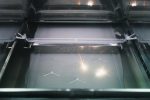Renishaws TEMPUS Boosts AM Efficiency, Cutting Build Times by Up to 50%
Renishaw, UK engineering technology company, has announced that its TEMPUS technology can reduce build times by up to 50% for users of its RenAM 500 series metal additive manufacturing (AM) systems. By utilizing advanced scanning algorithms to optimize layer sequencing, TEMPUS enhances productivity while maintaining part quality. While efficiency gains vary depending on geometry, components with thin, vertical features experience the most significant time savings.Renishaw showcased its TEMPUS solution at the Additive Manufacturing User Group (AMUG) Booth #P3 in Chicago from March 30 to April 3 and will also be RAPID + TCT Booth #1820 in Detroit from April 8-10.We are excited to introduce TEMPUS technology alongside the new RenAM 500 Ultra system, said Louise Callanan, Director of Additive Manufacturing at Renishaw. The time and cost savings offered by both TEMPUS and the RenAM 500 Ultra system will expand the viability of AM for mass production applications while also driving productivity gains for manufacturers seeking full-scale production at the lowest cost per part.Renishaw stressed that existing RenAM 500 series users can access TEMPUS technology as a paid upgrade, allowing them to maximize their investment. Additionally, the company highlighted its partnership with metal component specialist Alloyed, which has leveraged TEMPUS technology since 2021.Renishaws RenAM500Ultra. Photo via: RenishawTEMPUS Technology: Advancing AM ProductivityTraditional powder bed fusion systems require the recoater to distribute powder before laser consolidation can begin. However, TEMPUS synchronizes laser operation with recoater movement, eliminating up to nine seconds per layer and reducing total build times by tens of hours for multi-layer partsall while maintaining quality.In an interview with 3D Printing Industry, Chris Dimery, AM Business Manager EMEA at Renishaw, described TEMPUS as a time-saving technology and one of the companys largest developments in recent years. While typical cycle time reductions hover around 30%, some geometries can achieve up to 70% savings with TEMPUS.Reducing cost per part is critical to the wider adoption of AM technology. The dominant contributing factor to part cost for most components today is the time spent building the part on the machine itself. Reducing the amount of machine time per part therefore results in more cost-effective production, said Callanan.Renishaws TEMPUS. Photo via: RenishawIntroducing the RenAM 500 Ultra EnhancementsThe RenAM 500 Ultra enhances the RenAM 500 series with industry-leading optical, chamber, and gas-flow designs, as well as TEMPUS technology and advanced process monitoring software. Offering real-time build insights, it enables precise production control and in-process visibility. Designed for scalable, high-quality metal part production, the Ultra model allows manufacturers to meet evolving demands and produce complex geometries with ease.All RenAM 500 series systems, including the Ultra, are available in single-laser (500S) or quad-laser (500Q) configurations, ensuring efficient laser utilization, increased build speeds, and reduced cost per part. The Ultra model also features automated powder and waste handling systems, making it an ideal choice for high-volume production.Renishaws Collaborations with Its RenAM SolutionsIn March, Renishaw partnered with Cookson Industrial, a UK-based expert in precious metal AM, to reduce costs associated with 3D printing platinum-rhodium. By using Renishaws RenAM 500S Flex AM system, Cookson Industrial enhances material efficiency while producing high-temperature corrosion-resistant components, particularly beneficial for industries like glass fibre manufacturing.With platinum-rhodium prices averaging 80,000 per kilo, the company stressed that minimizing material waste is essential for economic feasibility. Cookson Industrial selected the RenAM 500S Flex, a laser powder bed fusion system optimized for R&D in AM, to address this challenge.In February, Connecticut-based Mott Corporation, a leader in high-precision filtration and flow control solutions, also expanded its manufacturing capabilities with the acquisition of a RenAM 500S Flex AM system. This integration has led to significant operational improvements, reducing machine turnaround and setup times by over 50% compared to previous AM technologies. Additionally, the system has improved part consistency, lowering the standard deviation of performance metrics by approximately 30%, enhancing reliability and performance in 3D printed components.Who won the 2024 3D Printing Industry Awards?Subscribe to the 3D Printing Industry newsletter to keep up with the latest 3D printing news.You can also follow us on LinkedIn, and subscribe to the 3D Printing Industry Youtube channel to access more exclusive content.Featured image showsRenishaws TEMPUS. Photo via: RenishawPaloma DuranPaloma Duran holds a BA in International Relations and an MA in Journalism. Specializing in writing, podcasting, and content and event creation, she works across politics, energy, mining, and technology. With a passion for global trends, Paloma is particularly interested in the impact of technology like 3D printing on shaping our future.


